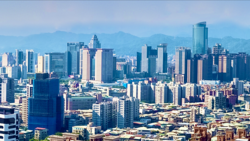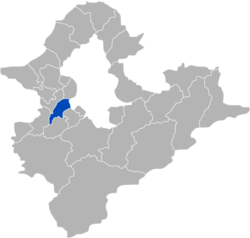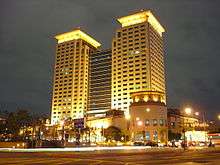Banqiao District
Banqiao District (Chinese: 板橋區; pinyin: Bǎnqiáo Qū) is a district and the seat of New Taipei City, Taiwan. It has the third-highest population density in Taiwan, with over 24,000 people per km2. Until the creation of New Taipei City, Banqiao (then transliterated as Banciao or Pan-ch'iao) was an incorporated county-controlled city and the former seat of Taipei County.
Banqiao 板橋區 Banciao, Panchiao | |
|---|---|
| Banqiao District | |
 | |
 Banqiao District in New Taipei City | |
| Coordinates: 25°00′40″N 121°26′45″E | |
| Country | Republic of China (Taiwan) |
| Special municipality | New Taipei City |
| Established | 1846 |
| Area | |
| • Total | 23.1368 km2 (8.9332 sq mi) |
| Population (January 2016)[1] | |
| • Total | 554,008 |
| • Density | 24,000/km2 (62,000/sq mi) |
| Time zone | UTC+8 (CST) |
| ZIP code | 220 |
| Area code(s) | 02 |
| Website | Banqiao.NTPC.gov.tw (in Chinese) |

Name origin
The district's old name was Pang-kio (Chinese: 枋橋; pinyin: Fāngqiáo; Pe̍h-ōe-jī: Pang-kiô; lit.: 'timbered bridge'), which dates back to the Qing Dynasty during the reign of the Qianlong Emperor (1735 - 1796 AD). A wooden bridge, locally called Pang-kio-thau (枋橋頭), was built for pedestrians to cross a brook located in the west of today's Banqiao, the modern day Nanzigou (湳仔溝, literally "Nanzi Creek"). The spellings Pankyu, Pankio, and Pankyo can be found in English-language works of the early 20th century.[2][3]
In 1920, the Japanese government modified the name to Itabashi (板橋, "planked bridge").[4] The same characters are still used today, but are read Bǎnqiáo in Mandarin. However, in Taiwanese Hokkien, the old name Pang-kiô is still the norm.
History
| Banqiao District | |||||||||||||||
|---|---|---|---|---|---|---|---|---|---|---|---|---|---|---|---|
| Traditional Chinese | 板橋區 | ||||||||||||||
| |||||||||||||||
In the early 20th century, Pankyo (Pankyu) was a walled city and said to be owned by a landlord who had lived there "in feudal style", surrounded by armed retainers.[2]
From 1920 to 1945, during Japanese rule, the area was administrated as Itahashi Town (板橋街), Kaizan District, Taihoku Prefecture.
Banqiao was upgraded from an urban township to a county-controlled city as Pan-ch'iao or Banciao City of Taipei County on 1 July 1972. The city became Banqiao District on 25 December 2010.
Geography

Banqiao is located in western part of the Taipei Basin of northern Taiwan, in the subtropical climate zone. Banqiao is surrounded by Taipei to the east, Sanchong to the north, Xinzhuang to the northwest, Shulin to the southwest, Tucheng to the south, and Zhonghe to the southeast. Banqiao is also bordered by two rivers, Xindian River to the northeast and Dahan River to the northwest.
Economy

Agriculture sector thrived in Banqiao in the 1950s. In the 1960s, manufacturing sector started to appear in the region and in the 1970s industries and commerce have developed. In the 1980 and '90s, finance and commerce grew in the area.[5]
Education
Banqiao is home to several universities, including the National Taiwan University of Arts. The National Banqiao High School is considered one of the top high schools in New Taipei City.
Universities and colleges
High schools
- Banqiao Senior High School
- New Taipei Municipal Haishan High School (新北市立海山高級中學)
- National Overseas Chinese High School(國立華僑高級中學)
- Kuang Jen Catholic High School (天主教光仁高級中學)
Tourist attractions

- Banqiao 435 Art Zone
- Banqiao Agricultural Park
- Cihui Temple
- Jieyun Temple
- Lehua Night Market
- Lin Family Mansion and Garden
- Nanya Night Market
- Paleo Wonders Mineral Fossil Museum
- Xinhai Constructed Wetland
- Stone Sculpture Park
- Zhenwu Temple
Sports facilities
Banqiao has several sports facilities (including Banqiao Stadium), and the annual New Taipei City sports game is hosted in the city.
Transportation

Banqiao is well served by multiple public transportation services. Banqiao station is served by THSR bullet trains and conventional rail TRA trains. Four metro stations are located in Banqiao on the Bannan line. All rails through Banqiao have been located underground since 1997. The future metro Circular line will also run through the district. Bus lines connect Banqiao with downtown Taipei and nearby cities.
Provincial Highway 3 and Provincial Highway 64 run through the district.
Sister cities


Notable residents
- Scott Chang - CEO of Lastertech
- Hsiao Chung-cheng, M.D. - Superintendent of Hsiao Chung-Cheng Hospital
- The Lin Ben Yuan Family
Notable natives
- Hsiao Huang-chi, singer, songwriter and judoka
- Ili, artist
- Lin Fong-cheng, Minister of Transportation and Communication (1998-2000)
- Lin Hsiung-cheng, banker and philanthropist
- Liu Ping-wei, member of Legislative Yuan (1999–2002)
- Yang Ya-che, film and television director
References
- 表 2-2. 都市計畫區面積及人口-按都市計畫區別分 (PDF). 中華民國內政部營建署全球資訊網 Construction and Planning Agency Ministry of the Interior,R.O.C (in Chinese). 2012. Retrieved 5 October 2019.
2板橋 Panchiao 13.60 570 000
- Chamberlain, B.; Mason, W.B. (1903). A Handbook for Travellers in Japan (7th ed.). London: J. Murray. p. 551. OL 25302448M.
Pankyo (Pankyu)
- Davidson, James W. (1903). The Island of Formosa, Past and Present : history, people, resources, and commercial prospects : tea, camphor, sugar, gold, coal, sulphur, economical plants, and other productions. London and New York: Macmillan. Index p.28. OCLC 1887893. OL 6931635M.
Pankyu. See Pankio
CS1 maint: ref=harv (link) - 細說板橋. Banqiao District Office. Archived from the original on 2011-08-08. Retrieved 2011-08-04.
- "Archived copy". Archived from the original on 2014-03-29. Retrieved 2014-03-28.CS1 maint: archived copy as title (link)
| Wikimedia Commons has media related to Banqiao District, New Taipei. |
| Wikivoyage has a travel guide for Banqiao. |